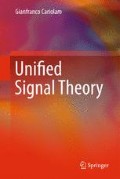Abstract
An I→J down-sampling, where J⊂I, performs a restriction of the signal domain, typically from a continuous domain I to a discrete domain J (lattice), with the consequent loss of signal values. Interpolation goes in the opposite direction, with the creation of new signal values, starting from the surviving samples. In this context, the basic problem is the recovery of the original signal from its samples. The structure of the recovery tf is potentially given by a J→I interpolator. The possibility of recovery must be investigated in the frequency domain and will be stated in terms of the band-limitation of the signal to be sampled. This leads to the celebrated Sampling Theorem, which represents a milestone of today’s digital signal processing and, more generally, of the information age. With the Unified Signal Theory, it is possible to formulate a Unified Sampling Theorem, which includes a variety of results as corollaries. Band-limitation is formulated in terms of a cell of the frequency domain, which must contain the support of the Fourier transform, and the interpolator too must be defined in terms of this cell.
Access this chapter
Tax calculation will be finalised at checkout
Purchases are for personal use only
Notes
- 1.
We are neglecting the noise which is always present in “real” systems.
- 2.
We tacitly assume that A 0 is real and positive.
- 3.
- 4.
We denote by G(f) a generic frequency response and by Q(f) the ideal frequency response that allows the exact recovery.
- 5.
If the frequency domain \(\widehat{I}\) is a continuum, the symmetry −C 0=C 0 may hold almost everywhere, that is, with the exception of some border points with measure zero.
References
A.L. Cauchy, Mémoire sur diverses formules dé analyse. Comptes Rendus 12, 283–298 (1841)
G. Cariolaro, A unified signal theory (topological approach), in Proc. of Italy–USA Seminary on Digital Signal Processing, Portovenere, Italy, August 1981
D.P. Petersen, D. Middleton, Sampling and reconstruction of wave-number-limited functions in N-dimensional Euclidean spaces. Inf. Control 5, 279–323 (1962)
H. Nyquist, Certain factors affecting telegraph speed. Bell Syst. Tech. J. 3, 324–346 (1924)
B.M. Oliver, J.R. Pierce, C.E. Shannon, The Philosophy of PCM. Proc. IRE 36, 1324–1332 (1948)
C.E. Shannon, Communication in the presence of noise. Proc. IRE 37, 10–21 (1949)
Author information
Authors and Affiliations
Corresponding author
Rights and permissions
Copyright information
© 2011 Springer-Verlag London Limited
About this chapter
Cite this chapter
Cariolaro, G. (2011). Unified Theory: Sampling and Interpolation. In: Unified Signal Theory. Springer, London. https://doi.org/10.1007/978-0-85729-464-7_8
Download citation
DOI: https://doi.org/10.1007/978-0-85729-464-7_8
Publisher Name: Springer, London
Print ISBN: 978-0-85729-463-0
Online ISBN: 978-0-85729-464-7
eBook Packages: EngineeringEngineering (R0)

